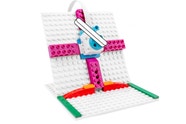Literary Randomiser
How can Daniel’s literary randomiser make choosing a book more exciting?

Prepare
- Review the Literary Randomiser lesson in the LEGO® Education SPIKE™ App.
- If you feel that it would be beneficial, pre-teach these related vocabulary words: genre, overwhelmed, randomiser and success.
- Consider the abilities and backgrounds of all your pupils. Differentiate the lesson to make it accessible to everyone. Please refer to the Differentiation section below for suggestions on how to do this.
- If time permits, plan and facilitate the language arts extension. Please refer to the Extension section below for further information.
Engage
(Whole Class, 5 Minutes)
- Facilitate a quick discussion about making decisions.
- Talk with your pupils about a time when they had to make a big decision.
- Ask questions like these: What criteria did you use to make the decision? How did you evaluate whether you were happy with your decision?
- Introduce your pupils to the story’s main characters and the first challenge: programming the literary randomiser to pick a book.
- Distribute a brick set and a device to each group.
Explore
(Small Groups, 30 Minutes)
- Have your pupils use the LEGO® Education SPIKE™ App to guide them through their first challenge:
- Create and test the program that picks the book genre.
- Have your pupils iterate and test their models to complete the next two challenges in the app:
- Modify the program to improve how the literary randomiser works.
- Design your own upgraded literary randomiser.
- You can find coding and building help in the Tips section below.
Explain
(Whole Class, 5 Minutes)
- Gather your pupils together to reflect on their completed challenges.
- Ask questions like these: What was Daniel’s problem? How did you help him to solve it? How did you improve Daniel’s literary randomiser? Why did you decide to make that improvement?
Elaborate
(Whole Class, 5 Minutes)
- Prompt your pupils to discuss and reflect on the process of setting success criteria to determine whether a solution was successful.
- Ask questions like these: Why is it important to set success criteria and understand what makes a solution successful? How do success criteria help you to improve something you have created?
- Have your pupils tidy up their workstations.
Evaluate
(Ongoing Throughout the Lesson)
- Ask guiding questions to encourage your pupils to ‘think aloud’ and explain their thought processes and reasoning in the decisions they have made while building and programming their models.
Observation Checklist
- Measure your pupils’ proficiency in defining the success criteria for evaluating a solution.
- Establish a scale that suits your needs. For example:
- Requires additional support
- Can work independently
- Can teach others
Self-Assessment
Have each pupil choose the brick that they feel best represents their performance.
- Yellow: I think that I can define the success criteria for evaluating a solution.
- Blue: I can define the success criteria for evaluating a solution.
- Green: I can define the success criteria for evaluating a solution, and I can also help a friend to do it.
Peer Feedback
- In their small groups, have your pupils discuss their experiences working together.
- Encourage them to use statements like these:
- I liked it when you…
- I would like to hear more about how you…
Tips
Coding Tips
- After your pupils have completed their first challenge, they will be provided with a map.
- Using the map, your pupils can experiment with the available Coding Blocks to modify their programs to follow the route for the trip.




Model Tip
- After your pupils have completed their second challenge, they will be provided with three Inspiration Images and an open-ended prompt, which will help them to improve their models.
- The Inspiration Images are meant to help spark their imaginations as they experiment and personalise their models.




There are no specific building instructions for this challenge.
Differentiation
Simplify this lesson by:
- Selecting one Inspiration Image to help your pupils personalise their models
- Experimenting with either the coding or the building
Increase the difficulty by:
- Changing how the literary randomiser is constructed
- Exploring new and different coding blocks within the program
Extension
- Have your pupils write stories based on the genre that was chosen by their literary randomisers. Make sure that they use narrative techniques, such as dialogue and description, to create a story that fits the genre.
If facilitated, this will extend beyond the 45-minute lesson.
ACELA1498
Incorporate new vocabulary from a range of sources into students’ own texts including vocabulary encountered in research
Teacher Support
The pupils will:
- Define success criteria to help evaluate a solution
- Compare and contrast different solutions to determine which one best meets the specified need
- Engage effectively in a range of collaborative discussions
(one for every two pupils)
- LEGO® Education SPIKE™ Essential Set
- Device with the LEGO® Education SPIKE™ App installed
Design and Technologies
ACTDEP014
Critique needs or opportunities for designing and explore and test a variety of materials, components, tools and equipment and the techniques needed to produce designed solutions.
Digital Technologies
ACELA1498
Incorporate new vocabulary from a range of sources into students’ own texts including vocabulary encountered in research.
English Language
ACELA1498
Incorporate new vocabulary from a range of sources into students’ own texts including vocabulary encountered in research.